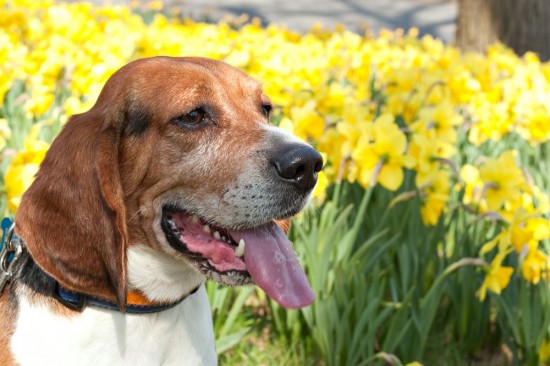

The spring time is a wonderful time of the year, winter is officially over and gardens, parks and woodlands are bursting with colour as bulbs and blossoms appear. The good weather makes us want to spend more time in the great outdoors enjoying what nature brings around every year. Of course, walking the dog is such a much more enjoyable experience too and you can bet your life, our four legged friends love to spend more time in the back garden. But did you know that daffodils and other beautiful flowers and spring plants are actually poisonous to dogs?
There are a lot of spring flowers that are poisonous to our canine friends. Very often these are the plants we all love to see burst into flower when the weather warms up because it brightens up the landscapes. Unfortunately, some dogs being dogs, adore digging holes whether in a back garden or out on a walk in a park and this is when they may just dig up a bulb or two and the results could be disastrous if they swallow or chew on them.
Lots of gorgeous spring flowers appear on lawns and this includes crocuses, tulips and daffodils. Unfortunately, all of these are very poisonous to dogs if they ingest them by mistake or nibble on them as they chew on some grass. It could happen when they are merrily digging away in the ground when often an excited dog may snatch at the earth with their mouths, picking up a bulb at the same time and then swallowing it.
If you have any species of lily in your back garden, again the bulbs can be deadly to dogs if they eat them. The whole bulb is not poisonous just part of it and it would only take as little as 15grams to kill a healthy dog. If a dog chews on the leaves or flowers of daffodils although it will not kill them, it will however, make your four legged friend very ill and you would have to seek veterinary attention as soon as you can.
Snowdrops, lily of the valley and aconite are other plants that appear on the landscape when the weather warms up and they are all toxic to dogs. If you do have any of these plants in your garden, you might want to think about removing them to avoid any health problems for your pet. However, if you ever see your dog nibbling at say a daffodil, then you would have to get them away from it straight away and then watch out they do not do it again.
It's lovely to see dogs running free in parks and along forest or woodland trails. However, this is when these areas tend to have magnificent displays of spring plants. Dogs tend to get excited when they are out on walks and often owners lose sight of their pets. This is not a good idea during the spring time because you never know when a dog might stop to eat some fresh grass and chew on a poisonous plant by mistake too. During the spring months, it might be wiser to keep your dog on a long lead when you are walking them where there are toxic plants growing. The other thing to consider is to never lose sight of them, so you can see if they nibble on anything they shouldn't.
Unfortunately there are no antidotes to the poisons that are found in daffodils and other toxic spring plants. This means if you notice your dog eating anything that will harm them, you need to get them to the vet immediately. A dog has to be made to vomit and then put on a drip to increase their chances of survival after eating a poisonous plant.
If you notice any of the following symptoms in your pet, you need to get them to see your vet as quickly as possible:
As soon as you call your vet, you need to give them as much information as you can about what happened and which plants you suspect your dog may have eaten. Below are the things you will need to do and tell your vet:
The sooner a dog that has eaten a poisonous plants gets to see a vet the more chance they have of surviving. The vet should be able to diagnose the problem and then offer the right treatment to your pet straight away, giving them a better chance of recovering from the toxins they have ingested.
Spring it is without a doubt one of the nicest seasons with splashes of colour bursting out all over the place. Parks and woodlands as well as back gardens look glorious. However, this is a dangerous time of the year for dogs and other pets because so many of these beautiful flowers and plants contain toxins which are deadly to them. The best way to avoid anything from happening is to be watchful and to react quickly if you think there's a problem. It goes without saying that like most things prevention is the best way to ensure your dog is not tempted to nibble on anything they shouldn't – however, this is not always possible.
Copyright © 2005-2016 Pet Information All Rights Reserved
Contact us: www162date@outlook.com